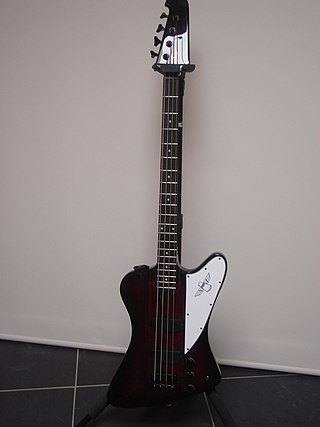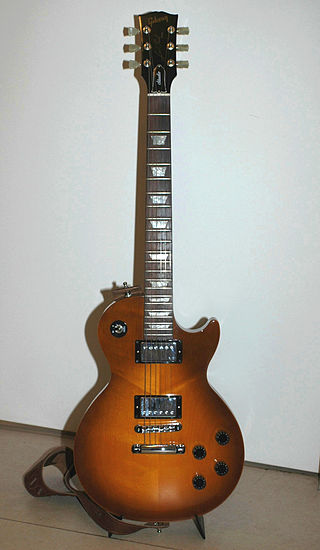This article needs additional citations for verification .(June 2017) |
The Ibanez Musician Bass was a line of electric bass guitars produced by the Ibanez Corporation from 1979 until 1987.
This article needs additional citations for verification .(June 2017) |
The Ibanez Musician Bass was a line of electric bass guitars produced by the Ibanez Corporation from 1979 until 1987.
The Musician series was introduced in 1979 with the MC-800 and MC-900 models, which were available in natural (NT) and "dark-stain" (DS) finishes. [1] List price for the MC-800 was $655.00 USD for the NT finish and $665.00 USD for the DS finish. List price for the MC-900 was $775.00 USD for the NT finish and $785.00 USD for the DS finish. [2] The MC-800 was a single-pickup design, while the MC-900 had two pickups and a three-band EQ.
The 1980 price list retains the MC-800 and MC-900, in both NT and DS finishes, but adds the MC-824, MC-924, MC-940, and MC-980 (8-string), all of which were DS models. [3]
The 1981 catalog lists four models: MC-824, MC-924, MC-924L, and MC-940. [4] [5] All four models were DS models, as the natural (NT) finish was no longer an option. The MC-824 was the base model, the MC-924 added a three-band EQ. The MC-924L was a left-handed version of the MC-924. The MC-940 was a fretless version of the same.
The 1983 catalog retains only two models, the MC-924 and MC-940, but introduces a new finish option, polar white (PW). [6] The 1983-1984 catalog shows a reintroduction of the MC-824DS and an additional finish option, metallic black (MB), for the MC-924 and MC-940 models.
The 1984 price list retains the 1983 models and introduces the MC-888, sometimes referred to as the "bean bass," which featured a smaller body. [7]
In 1986, only two models remain. The MC-924 is renamed MC2924 and the MC-940 is renamed MC2940. Their body shape is redesigned and looks more like what would eventually become the SoundGear line. [8] These are the only two Musician models in the 1987 price list. [9]
The Musician Bass featured a 34" scale neck-through design. The neck was 5-piece neck, constructed of three pieces of rock maple, with two strips of walnut in between them. The body was initially made from a sandwich of mahogany and ash - a mahogany core, with ash on the front and back. The mahogany core was discontinued in '82, leaving it with a solid ash body. From '79 to '81 they used Ibanez Super 4, single coil 'soapbar' pickups, which were also used in the Roadster basses of the same period. Starting in '82 they change to Ibanez Super P5 and Super J5 pickups, which were Precision and Jazz Bass style pickups in Ibanez' own covers. The MC824 model used a single J6 humbucking pickup with the Ibanez Tri-Sound switch, allowing series, parallel and single coil operation. All Musicians were passive basses, but the majority of models included an active equalizer circuit that could be switched in or out. From '79 to '81 they used a 3-way selector switch to change between the pickups. From '82 onward the two pickup models lost the switch and gained a blend control.
The various Musician models were endorsed and/or used by several high-profile musicians, including Sting of The Police, [10] Adam Clayton of U2, [11] Fleetwood Mac's John McVie, The Who's John Entwistle, [12] Mark Egan, [13] [14] Dee Dee Ramone, [13] Mike Porcaro of Toto, [15] Victor Bailey [15] and James Freud of Australian band The Models. [16] Sting's fretless Musician is said to be the instrument he used most in The Police. [17] [18] Adam Clayton used his Musicians as his main instruments from around 1981 through to 1984. He owned an MC824DS, which he favored, and an MC924DS. He later owned and used an MC888 'Bean' bass, which the Edge used for the song "40" on the original Joshua Tree tour [19] and can be seen in shots taken while recording the Zooropa album. Clayton used the MC888 for 'With or Without You' on the '17 Joshua Tree tour. [20]
In 2009, Ibanez produced a limited run of 15 MC30TH 30th anniversary Musician basses. The instruments were supposed to be the same as the original pre 1982 models, although differed in some significant ways. The body was ash, which they'd changed to in 1982, rather than the original ash/mahogany sandwich, but the biggest difference was with the electronics. The Ibanez advertising claimed they had reproduced the original Super 4 single coil pickups and EQ-B preamp/eq. The pickups, which featured wooden covers, were actually humbuckers that sounded nothing like the original single coil models and the preamp was a completely different circuit to the advertised EQ-B. Cosmetically they looked very similar to the pre 1982 models, with the addition of very ornate inlays on the fretboard and headstock and the wooden pickup covers. Built by their best craftsmen, the construction was outstanding. With a list price of US$10,666.65 in 2009, it took a long time for all the basses to sell. [21] [22]

An electric guitar is a guitar that requires external amplification in order to be heard at typical performance volumes, unlike a standard acoustic guitar. It uses one or more pickups to convert the vibration of its strings into electrical signals, which ultimately are reproduced as sound by loudspeakers. The sound is sometimes shaped or electronically altered to achieve different timbres or tonal qualities from that of an acoustic guitar via amplifier settings or knobs on the guitar. Often, this is done through the use of effects such as reverb, distortion and "overdrive"; the latter is considered to be a key element of electric blues guitar music and jazz, rock and heavy-metal guitar-playing. Designs also exist combining attributes of the electric and acoustic guitars: the semi-acoustic and acoustic-electric guitars.
Ibanez is a Japanese guitar brand owned by Hoshino Gakki. Based in Nagoya, Aichi, Japan, Hoshino Gakki were one of the first Japanese musical instrument companies to gain a significant foothold in import guitar sales in the United States and Europe, as well as the first brand of guitars to mass-produce the seven-string guitar and eight-string guitar. Ibanez manufactures effects, accessories, amps, and instruments in Japan, China, Indonesia, and the United States. As of 2017 they marketed nearly 165 models of bass guitar, 130 acoustic guitars, and more than 300 electric guitars. After Gibson and Fender, Ibanez is considered the third biggest guitar brand.

The Gibson Les Paul is a solid body electric guitar that was first sold by the Gibson Guitar Corporation in 1952. The guitar was designed by factory manager John Huis and his team with input from and endorsement by guitarist Les Paul. Its typical design features a solid mahogany body with a carved maple top and a single cutaway, a mahogany set-in neck with a rosewood fretboard, two pickups with independent volume and tone controls, and a stoptail bridge, although variants exist.

Music Man is an American guitar and bass guitar manufacturer. Originally formed in 1971 by Forrest White and Tom Walker, along with Leo Fender as a silent partner, the company started manufacturing electric and bass guitars under the Music Man name in 1974. In 1984 it was acquired by Ernie Ball, the subsidiary of which is branded as Ernie Ball Music Man.

The Fender Precision Bass is a model of electric bass guitar manufactured by Fender Musical Instruments Corporation. In its standard, post-1957 configuration, the Precision Bass is a solid body, four-stringed instrument usually equipped with a single split-coil humbucking pickup and a one-piece, 20-fret maple neck with rosewood or maple fingerboard.

Paul Reed Smith Guitars, also known as PRS Guitars or simply PRS, is an American guitar and amplifier manufacturer located in Stevensville, Maryland. The company was founded in 1985 in Annapolis, Maryland by Paul Reed Smith. Products manufactured by PRS include electric and acoustic guitars, basses, and amplifiers.

The Gibson Explorer is a type of electric guitar model by Gibson guitars, released in 1958. The Explorer offered a radical, "futuristic" body design, much like its siblings: the Flying V, which was released the same year, and the Moderne, which was designed in 1957 but not released until 1982. The Explorer was the final development of a prototype design that, years later, Gibson marketed under the name Futura.

Parker Guitars was an American manufacturer of electric and acoustic guitars and basses, founded by luthier Ken Parker in 1993. Parker guitars were distinguished for their characteristic light weight and the use of composite materials.

The Squier '51 is an electric guitar made by Squier, a subsidiary of Fender. The '51 is notable for being one of the few original designs made by Squier, which normally manufactures less expensive authorized copies of Fender's popular guitars and bass guitars.

The Gibson Thunderbird is an electric bass guitar made by Gibson and Epiphone.

The Fender Jaguar Bass is an electric bass guitar currently manufactured in Mexico by the Fender Musical Instruments Corporation.

The Ibanez RG is a series of electric guitars produced by Hoshino Gakki. The first model in the series, the RG550, was originally released in 1987 and advertised as part of the Roadstar series. That series was renamed "RG" in 1992 and all models since are simply known as RGs.

The Gibson Les Paul Studio is a solid body electric guitar produced by the Gibson Guitar Corporation since 1983. It is a model of Les Paul with some features omitted to appeal to musicians looking for the tonal qualities of the guitar but with less of an emphasis on cosmetics and to reduce the price of the instrument.

Greco is a Japanese guitar brand owned by the Kanda Shokai Corporation (in Japanese) 神田商会, a musical instrument wholesaler mostly known for being part of Fender Japan. Instruments manufactured with the name "Greco" are electric and acoustic guitars.

The Ibanez Iceman is a guitar produced by Hoshino Gakki under the Ibanez brand.
Electric guitar design is a type of industrial design where the looks and efficiency of the shape as well as the acoustical aspects of the guitar are important factors. In the past many guitars have been designed with various odd shapes as well as very practical and convenient solutions to improve the usability of the object.

Epiphone Genesis refers to three Genesis Series models ever produced
The Yamaha Corporation is a multinational corporation and conglomerate based in Japan with a wide range of products and services, predominantly musical instruments, motorcycles, power sports equipment and electronics.
The Fender Telecaster, colloquially known as the Tele, is an electric guitar produced by Fender. Together with its sister model the Esquire, it was the world's first mass-produced, commercially successful solid-body electric guitar. Its simple yet effective design and revolutionary sound broke ground and set trends in electric guitar manufacturing and popular music.